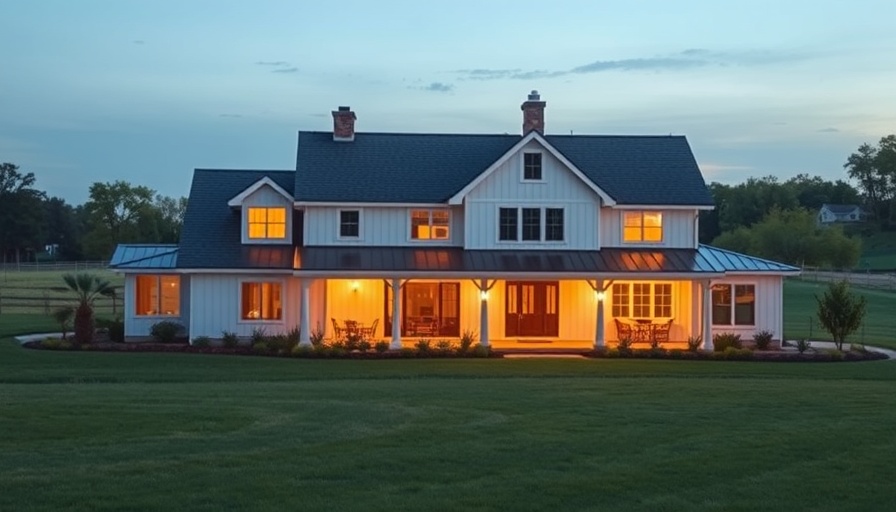
The Shift in American Living Preferences
The American dream is evolving. Once defined by suburban neighborhoods filled with white picket fences and neatly manicured lawns, it's now transformed by trends like remote work and skyrocketing housing prices. Today's homebuyers are asking important questions as they navigate rising home costs and changing lifestyles: exurbs vs. suburbs—what does it mean for them? Understanding this comparison is essential for prospective homeowners who want to align their living situations with their personal and financial circumstances.
Understanding Exurbs vs. Suburbs
At their core, both exurbs and suburbs stem from a desire for space, privacy, and the ease of access to urban conveniences. However, key differences make each environment unique. Suburbs often serve as densely populated transitional areas just outside of urban centers. Conversely, exurbs represent the outer ring of communities that extend beyond suburban areas, often exhibiting a more open, rural feel.
Proximity is a significant differentiator: suburbs tend to offer shorter commuting times with better public transport options, while exurbs typically feature more spaced-out developments that necessitate longer, car-dependent travel to urban cores. While suburbs showcase a blend of housing styles—encompassing single-family homes, townhouses, and even rental options—exurbs primarily consist of single-family homes, providing more room to breathe but often limited rental availability.
The Advantages and Disadvantages of Exurb Living
Pros of Living in the Exurbs
- Space and Privacy: Exurban properties often provide larger plots of land, appealing to buyers who prioritize outdoor space and personal privacy.
- Lower Housing Costs: Greater affordability in housing prices can be a major attraction, especially for families or those securing investment properties.
- Natural Environment: Exurban areas typically offer a quieter, more rural environment conducive to outdoor activities and a relaxed lifestyle.
Cons of Living in the Exurbs
- Increased Commute: The trade-off for lower housing costs often results in longer, more demanding commutes to work or urban amenities.
- Limited Amenities: Exurbs generally offer fewer shopping, dining, and entertainment options, which can require more planning for daily life.
- Underdeveloped Infrastructure: Less established communities may lack essential services like hospitals, schools, and public transportation.
Exploring Suburban Living
Suburbs strike a balance between urban access and residential comfort. They serve as community-oriented environments where amenities are plentiful, ensuring that families can meet their shopping, dining, and entertainment needs.
Pros of Living in Suburbs
- Accessible Amenities: Proximity to shopping centers, schools, and recreational venues makes daily living relatively easy.
- Shorter Commutes: Most suburbs offer easier access to public transport and city centers.
- Community Feel: Homes situated closely together foster social interactions and a sense of belonging.
Cons of Living in Suburbs
- Higher Costs: Living closer to the city usually incurs higher housing and living costs.
- Limited Space: Densely populated areas may lack the space and privacy that many people value.
- Less Rural Appeal: Some may find the suburban atmosphere less appealing compared to more natural exurban environments.
Future Trends in Housing Preferences
The distinction between exurbs and suburbs is poised to reshape the real estate market in the coming years. With the growing acceptance of remote work and the shifting economics of housing, many families may find exurb living increasingly attractive. Lower housing costs combined with the allure of a calmer lifestyle can appeal to the emerging demographic of homebuyers.
What’s Right for You?
Deciding between exurbs and suburbs boils down to your lifestyle preferences, financial situation, and accessibility needs. Consider factors like your commute, prior engagement with local amenities, and how much space you desire in your new home.
Whether you lean toward the calmer, space-rich life in the exurbs or the amenity-focused vibrancy of suburban living, being informed about their unique offerings is paramount for making the right decision.
Conclusion and Next Steps
As you embark on your home-buying journey, consider reaching out to a local real estate agent who can provide valuable insights based on current market trends. With resources available through websites like Zillow, Trulia, and Redfin, you can explore properties for sale and begin your search for the perfect home that aligns with your vision of the American dream. Don’t miss out on finding your ideal living situation—start your house hunting today!
 Add Row
Add Row  Add
Add 




Write A Comment